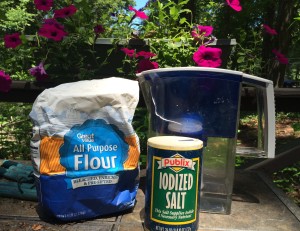Kids are fascinated to work with clay, but if it is not available it is easy make homemade clay for kids. Although natural clay from the earth is preferred in most cases, there are many advantages to making your clay at home. The supplies are very common and usually already available in the home. Natural clay requires being fired (cooked at very high temperatures) in a pottery kiln. Home made clay does not and a kitchen oven will suffice. The process is very quick. Homemade clay can also be used for most art projects and can be painted. Some recipes allow for cooking in a home oven to harden the clay but some are self hardening. It has been my experience that the self hardening varieties are more stiff to work with and do not hold up long-term as well as the types that can be heated in a home oven for hardening. Also the homemade clay that has been cooked in a n oven works better if you want to paint it. Acrylic paints are best to paint it, but remember that these are permanent so this might not be suitable for very young children. If they get the paint on their clothes it will cot come out unless scrubbed immediately. Tempera paints can also be used, but remember they are not permanent and if the finished project gets wet, the paint will run and come off. Homemade clay is also wonderful for school projects. Since the ingredients are usually staples that most kitchens have, it is a spontaneous art activity the kids can enjoy at the last moment without a lot of planning. I have used homemade clay in school projects for classes also. The project the classroom teachers had in mind was something that could not be fired in a kiln because of the size and the school did not have a pottery kiln. To mix the quantity needed of the homemade clay, I borrowed the mixers and bowls from the school cafeteria.
Materials
large bowl
cookie sheet
board or wax paper to lay on hard dry surface for kneading
wax paper or foil
plastic wrap
4 cups flour
2 cups salt
2 T vegetable or canola oil
1 cup warm water
1/2 cup more water to be used while mixing
Process
In the large bowl, place the 4 cups of flour and 1 cup salt and mix together with a large spoon. Make a well or large indention in the center with the spoon and pour the cup of water into it. Stir with a spoon until combined a little and then use your hands. Add 1/2 cup more warm water and continue mixing. Knead 5 minutes on a floured board or floured sheet of wax paper or foil on a hard surface. The mixture should be very smooth.
For projects, divide the clay into smaller portions. Any left over homemade clay can be wrapped in plastic for use at another time. If the clay dries out, add a few drops of water and knead until it becomes smooth again. Have the child work on a piece of plastic or foil. If it becomes sticky on their hands or the surface, add a little flour.
When the sculpture is complete, bake in the oven for 325 degrees on a cookie sheet for 1 hour until hard. It should be hard when tapped with a knife.
Dough can be colored with food coloring while mixing but will be a paler color after cooking. When cooled, items can be painted with acylics or tempera paints. Watercolors turn out very pale and don’t work as well.. For a shiny finish use thinned white glue and brush on the items after cooking and cooling.
Some suggestions for projects
free form projects
dragons
butterflies
beads
insects
jewelry
molds, impressions
napkin rings
ornaments – use cookie cutters or make patterns out of cardboard. To make holes, use a plastic straw
picture frames
pretend food for play
Home made clay for kids is a guaranteed pleaser and offers many creative options for classroom teachers, home school students and for parents that are looking for more creative options for their children. When I was teaching inner city school, the kids loved it and begged for the recipe so they could have their mothers make it for them at home. It is also wonderful for adults and crafts. I have made Christmas ornament that have lasted years. It is one of the easiest and most diverse art options I know of. Give it a try and sign up for my newsletter for more creative learning activities for kids.
Latest posts by Jan Watford (see all)
- Your First Time Hanging Out with Squirrly - April 23, 2019
- Jan C Watford Illustrations for 2017 - February 15, 2018
- My Illustrations Last Quarter of 2016 - February 15, 2017
